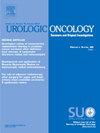低级别尿路上皮癌中高级别尿路上皮癌的临界百分比的临床意义:决定因素?
IF 2.3
3区 医学
Q3 ONCOLOGY
Urologic Oncology-seminars and Original Investigations
Pub Date : 2025-05-01
DOI:10.1016/j.urolonc.2024.10.016
引用次数: 0
摘要
目的:该研究旨在分析在尿路上皮癌(UC)中具有临床意义的高级别(HG)成分百分比的临界值:该研究共纳入 362 例患者,混合级 UC(MGUC)患者根据 HG 面积小于 5%的情况被划分为联合组(CG)1。高级别乳头状 UC(HGPUC)患者根据 HG 成分比例分组:CG2(≥5%-结果:在癌症特异性生存率(CSS)方面,低级别乳头状 UC(LGPUC)与 CG1、CG2 或 CG3,以及 LGPUC 与 PHGPUC 之间的差异具有统计学意义(危险比 (HR) = 19.85,95% 置信区间(CI)= 2.30-171.10 P = 0.007;HR = 28.38,95% CI = 3.50-229.97 P = 0.002;HR = 18.64,95% CI = 2.26-153.64 P = 0.007;HR = 35.41,95% CI = 4.61-271.72 P <0.001)。在CSS方面,PHGPUC与CG1、CG2或CG3之间没有统计学意义上的差异:这些研究结果表明,即使 LGPUC 中 HGPUC 的比例低于 5%,也会对 CSS 产生显著影响。此外,HGPUC 的百分比超过 5%,也不会对 CSS 产生重大影响。基于这些研究结果,披露高级别成分的百分比可能对未来的患者管理和治疗至关重要。本文章由计算机程序翻译,如有差异,请以英文原文为准。
The clinical relevance of cut-off percentage for high-grade urothelial carcinoma within low-grade urothelial carcinoma: A determining factor?
Aims
The aim of the study was to analyze the cut-off value for the percentage of the high-grade (HG) component that has clinical significance in urothelial carcinoma (UC).
Material and Methods
The study included a total of 362 patients, mixed-grade UC (MGUC) patients were classified as Combine Group (CG) 1 based on the presence of less than 5% HG areas. High-grade papillary UC (HGPUC) patients were grouped based on HG component proportions: CG2 (≥5%–<50% HG), CG3 (≥50%–<100% HG), and pure HGPUC (PHGPUC) for 100% HG components.
Results
There was a statistically significant difference between low-grade papillary UC (LGPUC) and CG1, CG2, or CG3, as well as LGPUC and PHGPUC, in terms of cancer-specific survival (CSS) (hazard ratio (HR) = 19.85, 95% confidence interval (CI) = 2.30–171.10 P = 0.007, HR = 28.38, 95% CI = 3.50–229.97 P = 0.002, HR = 18.64, 95% CI = 2.26–153.64 P = 0.007, and HR = 35.41, 95% CI = 4.61–271.72 P < 0.001, respectively). There was no statistically significant difference between PHGPUC and CG1, CG2, or CG3 in terms of CSS.
Conclusions
These findings suggest that even the presence of less than 5% HGPUC within LGPUC significantly impacts CSS. Furthermore, the increase in the percentage of HGPUC beyond 5% does not substantially influence the CSS. Based on these findings, disclosing the percentage of the high-grade component may be crucial for future patient management and treatment.
求助全文
通过发布文献求助,成功后即可免费获取论文全文。
去求助
来源期刊
CiteScore
4.80
自引率
3.70%
发文量
297
审稿时长
7.6 weeks
期刊介绍:
Urologic Oncology: Seminars and Original Investigations is the official journal of the Society of Urologic Oncology. The journal publishes practical, timely, and relevant clinical and basic science research articles which address any aspect of urologic oncology. Each issue comprises original research, news and topics, survey articles providing short commentaries on other important articles in the urologic oncology literature, and reviews including an in-depth Seminar examining a specific clinical dilemma. The journal periodically publishes supplement issues devoted to areas of current interest to the urologic oncology community. Articles published are of interest to researchers and the clinicians involved in the practice of urologic oncology including urologists, oncologists, and radiologists.

 求助内容:
求助内容: 应助结果提醒方式:
应助结果提醒方式:


